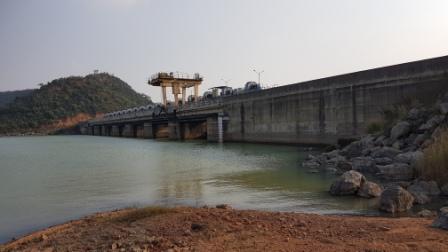Bhubaneswar/Raigarh: Water from the controversial Kelo dam in Chhattisgarh’s Raigarh district, which was constructed in 2012 to provide irrigation facilities to nearby villages, has been playing truant, causing hardship to the farmers and villagers of downstream areas of Chhattisgarh and Odisha.
With very little work being done to provide water for farming in areas of close vicinity and erratic release of water from the dam to its other side, the problems are escalating.
The farmers in Odisha as well as Chhattisgarh are reported to receive interrupted flow of the Kelo waters, one of the major tributaries of the Mahanadi in Odisha. The dam is situated before the Hirakud dam and joins the Mahanadi River near the Jharsuguda district.
A spot visit to the dam site by this correspondent revealed drastic differences of the supply of the Kelo river waters from the dam to the other side. Many experts who had been to the dam and aggrieved villagers claim farmers have expressed their woes over their farming being hit.
“Villagers on the other side should also been given the benefit of the river water. There should not be discrimination and their revenues should not be lost after the coming up of the dam. This already added to the woes of many who were displaced,” said Kanu Ram, a resident of Lakha village, close to the dam.
Ranjan Panda, a noted environmentalist and researcher on Mahanadi told Orissa POST, “During our visits to such villages we interacted with the farmers in Chhattisgarh and Odisha. Farmers told us that there irrigation potential from Kelo river had indeed been marred after the dam was built. The areas of Kelo river before it joins Mahanadi in Odisha have indeed been affected.”
He however, said that there had been little scientific evidence present to claim that the Kelo river had been affecting the overall flow of Mahanadi in Odisha. “There is lack of data and we need more scientific studies to prove that,” he added while terming the role of Central Water Commission (CWC) in the whole exercise ‘dubious’.
The Odisha government in their petition before the Supreme Court and several other communications with the Union government had been complaining that the dam was constructed on the Kelo river without apprising the state government about it. It also alleged that the dam had been obstructing the normal flow of the river to Mahanadi and hampering the prospects of farmers and people dependent on the river for their livelihood.
The Union government meanwhile in the Parliament had told Odisha government that as the construction of the dam started in 2009, Odisha government should have objected it before 2006-2009 when the overall planning and execution works were taken up in Chhattisgarh.
Manish Kumar, OP







































